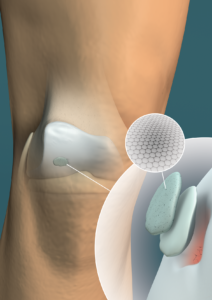 Through a joint collaboration between the BioRobotics Institute of the Scuola Superiore Sant’Anna and the Rizzoli Orthopedic Institute, a double-layer hydrogel that mimics the characteristics of joint cartilage has been created and allows to restore its natural properties in areas where the tissue was damaged. The discovery, presented in a study published in the international journal Advanced Healthcare Materials, aimed at defining a possible intervention strategy for the resolution of joint problems affecting the knee, through the use of a functional material to recovery mechanical and lubricant properties of articular cartilage damaged as a result of trauma or osteoarthritis.
Through a joint collaboration between the BioRobotics Institute of the Scuola Superiore Sant’Anna and the Rizzoli Orthopedic Institute, a double-layer hydrogel that mimics the characteristics of joint cartilage has been created and allows to restore its natural properties in areas where the tissue was damaged. The discovery, presented in a study published in the international journal Advanced Healthcare Materials, aimed at defining a possible intervention strategy for the resolution of joint problems affecting the knee, through the use of a functional material to recovery mechanical and lubricant properties of articular cartilage damaged as a result of trauma or osteoarthritis.
 “The hydrogel we developed – says Diego Trucco, first author of the study and PhD student of the Institute of BioRobotics of the Sant’Anna School of Advanced Studies – is composed of two layers: the first mimics the mechanical and lubricating characteristics of the surface area of the human cartilage; the second goes deeper, reproducing the mechanical characteristics of the knee cartilage. The hydrogel does not contain cells (chondrocytes or stem cells) but can be considered as a synthetic acellular substitute “.
“The hydrogel we developed – says Diego Trucco, first author of the study and PhD student of the Institute of BioRobotics of the Sant’Anna School of Advanced Studies – is composed of two layers: the first mimics the mechanical and lubricating characteristics of the surface area of the human cartilage; the second goes deeper, reproducing the mechanical characteristics of the knee cartilage. The hydrogel does not contain cells (chondrocytes or stem cells) but can be considered as a synthetic acellular substitute “.
The researchers’ idea is to sequentially inject the two hydrogels with minimally invasive surgical techniques, such as arthroscopy, for example. Another feasible way is to compose the hydrogels “externally” and implant them surgically, replacing the damaged tissue area exactly. Currently, thanks to the support of the Rizzoli Orthopedic Institute, two very important validation tests have been carried out: the analysis of the cytotoxicity of the materials with the main cells of the cartilage, the chondrocytes; and the validation of the properties of the material through the use of a knee simulator capable of simulating a person’s daily activity. The tests carried out so far have given positive results. However, further pre-clinical tests will have to be carried out before a possible validation of the material, at the clinical study level, could be considered.
“The study – explains Lorenzo Vannozzi, project manager of the BioRobotics Institute – is part of the research activity conducted within the European project H2020 ADMAIORA and was born as a parallel strategy to the main focus of the project, focused on a purely regenerative approach which is based on enabling technologies such as ultrasounds “.
“The close collaboration between various professional figures such as engineers, biologists, physicists as happened in this study – says Gina Lisignoli, Biologist Director of the Immunoreumatology and tissue regeneration Laboratory at the Rizzoli Orthopedic Institute – was fundamental to achieve important results and this approach represents an important step in the transfer of results from the laboratories to the clinic”.
“This result is combined with other interesting discoveries that we are making within the ADMAIORA project. We are confident that this and other technologies can turn into a clinical reality within a few years “says Leonardo Ricotti, associate professor of the BioRobotics Institute and scientific director of the Regenerative Technologies Lab.
Please find the article here
